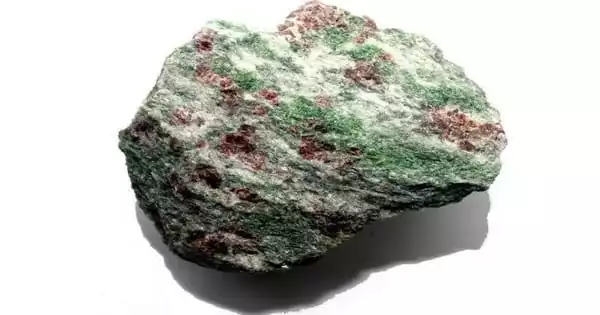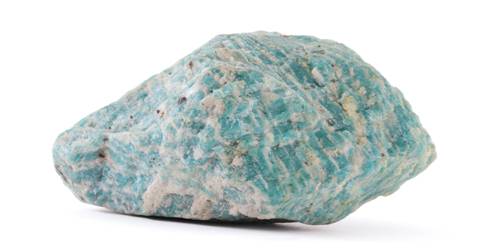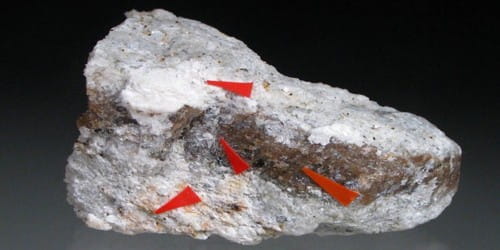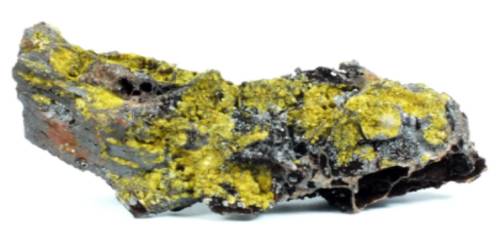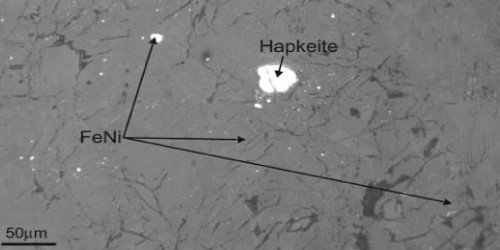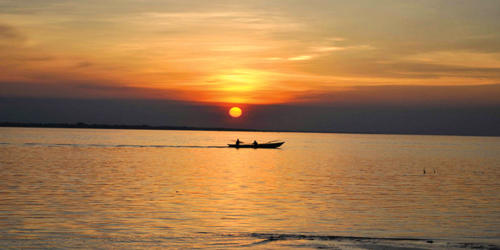Omphacite is a silicate mineral in the clinopyroxene group with the formula: (Ca, Na)(Mg, Fe2+, Al)Si2O6 is a rare pyroxene group member. It is a chemical intermediary between Augite and Jadeite. It is a clinopyroxene that ranges from deep green to pale green or nearly colorless. It is most commonly found in eclogite, a basalt high-pressure metamorphic rock. Along with pyrope garnet, it is a major mineral component of eclogite and can also be found in blueschist facies and UHP (ultrahigh-pressure) metamorphic rocks.
General Information
- Category: Pyroxene
- Formula: (repeating unit) (Ca,Na)(Mg,Fe2+,Al)Si2O6
- Crystal system: Monoclinic
- Crystal class: Prismatic (2/m) (same H-M symbol)
- Space group: P2/n or C2/c
- Color: Green to dark green; colorless to pale green in thin section

Properties
Omphacite is a solid solution of diopside and jadeite containing Fe. It crystallizes in the monoclinic system with prismatic, twinned forms that are usually anhedral. It has the typical pyroxene cleavage at about 90°. It has a Mohs hardness of 5 to 6 and a specific gravity of 3.29 to 3.39.
- Crystal habit: Rarely in rough crystals; anhedral, granular to massive
- Fracture: Uneven to conchoidal
- Tenacity: Brittle
- Mohs scale hardness: 5-6
- Luster: Vitreous to silky
- Streak: Greenish white
- Diaphaneity: Translucent
- Specific gravity: 3.16-3.43
- Optical properties: Biaxial (+)
- Formation and occurrence
Formation
Omphacite is the dominant phase in the Earth’s upper mantle’s subducted oceanic crust. Omphacite, garnet, and high-pressure silica phases are the main mineral components of eclogite (coesite and stishovite). It is also found in kimberlite eclogite xenoliths and crustal rocks metamorphosed at high pressures. The omphacite in eclogite gradually transforms to majoritic garnet as depth increases. Omphacite is stable in the Earth’s interior to a depth of 500 km. Omphacite can be stable even in the deeper mantle due to the cold geotherm of subducted slabs.
Chemical composition
Omphacite is a solid solution of diopside (CaMgSi2O6) and jadeite containing Fe (NaAlSi2O6). The chemical composition of omphacite varies continuously from pure diopside to pure jadeite, depending on how much the coupled substitution of (Na, Al)-(Mg-Fe, Ca) occurs. Furthermore, coupled substitution stiffens the crystals.
Occurrences
It can be found in blueschist facies as well as ultrahigh-pressure metamorphic rocks. It is also found in kimberlite eclogite xenoliths and crustal rocks metamorphosed at high pressures. It was discovered in the Münchberg Metamorphic complex in Franconia, Bavaria, Germany, in 1815. The name omphacite comes from the Greek word omphax, which means “unripe grape” because of its characteristic green color.
Except for the major minerals, associated minerals in eclogites include rutile, kyanite, phengite, and lawsonite. In blueschist facies metamorphic rocks, minerals such as glaucophane, lawsonite, titanite, and epidote coexist with omphacite.
